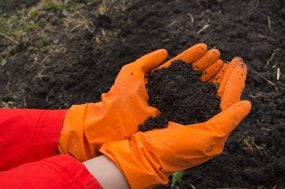Key points
- Soil that is contaminated with lead is a source of lead exposure for a child.
- Children can be exposed to lead in soil by swallowing or breathing in lead-contaminated soil while playing.
- Avoiding contact with bare soil can reduce or eliminate individuals' exposure to lead in the soil.
- You should contact your child's healthcare provider if you think your child has been exposed to lead in soil.

Overview
Lead-contaminated soil continues to be a hazardous source of lead exposure for young children in the United States.
Deposits from leaded gasoline, exterior lead-based paint, and industrial sources have contributed to increased levels of lead in the soil. This is especially common in urban areas and homes built before 1978.
Exposure
Lead exposure from soil
Children can be exposed to lead in soil by swallowing or breathing in lead-contaminated soil while playing. Lead-contaminated soil particles can also be brought inside as lead dust or on shoes, clothing, or pets.
Young children tend to put their hands, which may be contaminated with lead dust from soil, into their mouths. Some young children eat soil (this is called pica). Children may also be exposed to lead by eating fruits and vegetables grown in or near lead-contaminated soil.
Lead exposure from artificial turf
The risk for harmful lead exposure is low from new fields with elevated lead levels in their turf fibers. This is because the turf fibers are still intact, and the lead is unlikely to be available for harmful exposure. As the turf ages and weathers, lead is released in dust that could then be ingested or inhaled, increasing lead exposure risk. If exposures do occur, CDC currently does not know how much lead the body will absorb.
Some artificial turf playing fields may also contain potentially unhealthy levels of lead dust. Artificial turf made of nylon or nylon/polyethylene blend fibers contains levels of lead that pose a potential public health concern. Tests of artificial turf fields made with only polyethylene fibers showed that these fields contained very low levels of lead.
Several factors cause harmful levels of lead in an artificial field. Fields that are old, used frequently, or are exposed to weather may break into dust.
Prevention tips
Remove shoes in the house
Take off shoes when entering the house to prevent bringing lead-contaminated soil in from outside.
Reduce children's exposure to soil
Prevent children from playing in bare soil. If possible, provide them with sandboxes. Cover sandboxes when not in use to prevent cats from using it as a litter box.
Cover exposed soil
Plant grass on areas of bare soil or cover the soil with grass seed, mulch, or wood chips, if possible. Until the bare soil is covered, move play areas away from bare soil and away from the sides of the house.
Avoid using contaminated soil
Do not grow fruits or vegetables in lead-contaminated soil. Using a container garden is a good alternative.
Testing children for lead exposure
You should contact your healthcare provider if you think you or your child has been exposed to lead in water. Most children and adults who are exposed to lead have no symptoms.
The best way to tell if someone has been exposed is with a blood lead test. A health care provider can decide whether a blood lead test is needed. They may also recommend appropriate follow-up actions if a child has been exposed. As levels of lead in the blood increase, adverse effects from lead may also increase.
Resources
- All Children Can Be Exposed to Lead – real-world examples of situations where children have been exposed to lead. (Printable PDF)
- Federal Research on Recycled Tire Crumb Used on Playing Fields – a coordinated effort by federal agencies to study key environmental and human health questions about risks from artificial turf.
- Lead in Soil – information about lead-contaminated soil from the Environmental Protection Agency.
- Soil Screening, Health, Outreach and Partnership (soilSHOP) – health education and outreach events for lead in soil by the Agency for Toxic Substances and Disease Registry. The soilSHOP events help people learn if their soil is contaminated with lead and how to reduce exposures to contaminated soil and produce.
